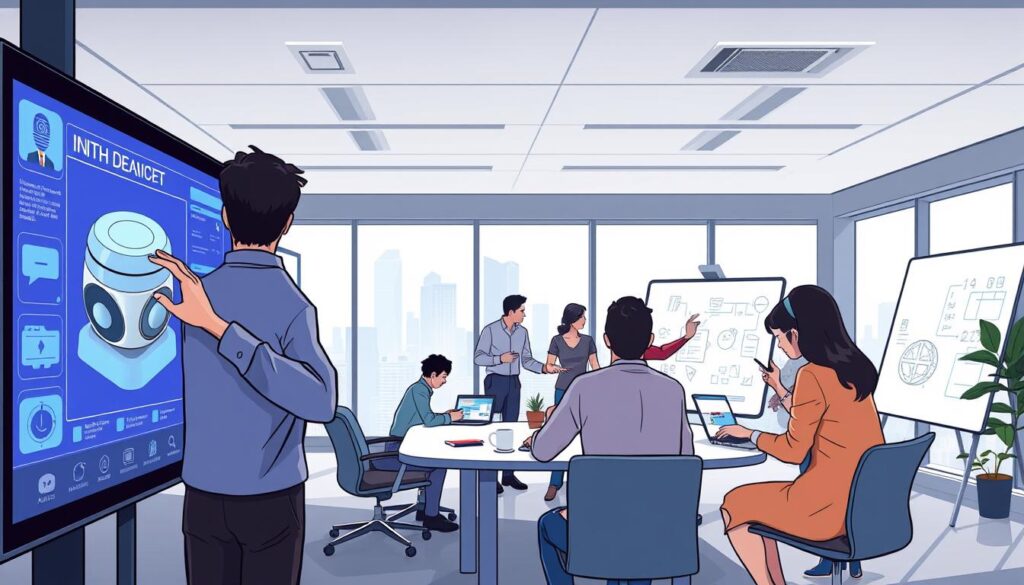Imagine creating groundbreaking items faster than ever. Tools powered by advanced technology are reshaping how businesses approach innovation. From self-driving cars to apps that predict user preferences, smart systems now handle tasks once reserved for human creativity. This shift isn’t just about automation—it’s about redefining what’s possible.
In this article, you’ll discover how to leverage these tools as your virtual partner. Learn step-by-step methods to generate fresh concepts, refine workflows, and prioritize customer needs. Whether you’re refining an existing business model or launching something entirely new, these strategies unlock efficiency.
Why does this matter? Markets move faster than ever. Teams that embrace these digital solutions gain a clear edge. You’ll see real-world examples of companies boosting collaboration and cutting development time by 40% or more.
Ready to transform your approach? Let’s explore how blending human insight with machine precision creates winning results.
Introduction to AI in the World of Product Design
From sci-fi dreams to design studios, AI’s journey reshapes how we approach creation. Early experiments in the 1980s used basic algorithms for pattern recognition. Today, these systems analyze market trends and user behavior to suggest features you might overlook.
The Evolution of AI in Creative Industries
Graphic design tools in the 2000s first hinted at automation’s potential. Adobe’s Sensei platform, launched in 2016, marked a turning point. It could auto-crop images and suggest layouts—tasks that once took hours. Now, platforms generate entire branding kits from text prompts.
Fashion brands like Stitch Fix use machine learning to predict style preferences. Automotive companies simulate crash tests digitally before building prototypes. This shift from manual drafting to predictive modeling saves time and reduces waste.
What You Can Expect from This Guide
You’ll learn how to blend human creativity with data-driven insights. Case studies show teams cutting concept-to-launch cycles by 58% using collaborative AI tools. We’ll explore platforms that turn rough sketches into 3D models overnight.
Practical exercises will teach you to interpret AI-generated feedback loops. Discover how to validate ideas against real-time consumer data. By the end, you’ll know which tools align with your workflow—and when to trust your instincts over algorithms.
Mastering AI-Powered Product Design: Invent and Sell New Products with a Virtual Brainstor
Transforming raw concepts into market-ready solutions just got smarter. Modern systems analyze patterns across industries to spark unexpected connections. This approach turns fragmented thoughts into actionable blueprints faster than manual methods.
Key Benefits of AI in Product Ideation
Tools like FigJam AI generate hundreds of ideas in minutes. They cross-reference trends from unrelated fields—like gaming mechanics in fitness apps. Teams at companies like Philips use these platforms to reduce research tasks by 70%.
Clustering algorithms group similar concepts visually. This helps spot gaps in your innovation pipeline. Miro’s AI whiteboard feature turns sticky notes into organized workflows automatically.
Integrating Virtual Brainstorm Techniques
Blend traditional workshops with platforms like Taskade. Its AI suggests prompts when conversations stall. One automotive team combined sketch sessions with real-time insights from user forums.
These hybrid methods keep creativity flowing without sacrificing structure. Case studies show teams using this approach launch features 3x faster. The key? Letting algorithms handle data crunching while humans focus on strategic choices.
Leveraging AI for Enhanced Ideation and Product Development
Breaking through creative barriers requires more than human effort alone. Modern systems analyze patterns across millions of data points to uncover opportunities hidden in plain sight. This approach turns vague concepts into polished solutions while keeping customers at the core.

Using AI Tools for Rapid Brainstorming
Platforms like ChatGPT generate 50+ ideas in 90 seconds by cross-referencing global trend databases. A beverage company used this method to develop eco-friendly packaging concepts, cutting brainstorming time by 65%. Miro’s AI whiteboard clusters suggestions into actionable themes automatically.
These tools excel at connecting unrelated industries. One team combined travel app features with fitness tracking data to create a hotel loyalty program. The result? A 40% faster development cycle compared to traditional workshops.
Validating Product Ideas with Data-Driven Insights
Sentiment analysis tools like Brandwatch scan social media to predict user reactions. A skincare brand avoided a $2M mistake by testing product names through AI-powered emotion detection. Systems analyze historical sales data to forecast demand with 89% accuracy.
Follow these steps to integrate validation:
1. Feed prototype feedback into AI analytics platforms
2. Compare results against real-time market trends
3. Adjust features using prioritized insights
Teams using this method report 30% higher customer satisfaction scores. The key lies in balancing creative risks with empirical validation.
Utilizing Virtual Brainstorming Tools for Creative Breakthroughs
The future of creative teamwork lives in digital workspaces. Modern platforms turn scattered thoughts into structured innovation pipelines, letting teams build on each other’s insights across time zones. Gone are days of unproductive meetings—today’s tools blend human spontaneity with machine precision.

Exploring Top AI Ideation Platforms
Leading solutions like Miro AI and FigJam AI redefine collaborative product development. Miro’s sticky note clustering organizes 500+ ideas into themes automatically. UX Pilot generates editable wireframes from rough sketches, cutting feedback cycles by half.
These tools excel at cross-functional alignment. Designers at companies like Spotify use FigJam’s template library to run global workshops. Real-time voting features help prioritize concepts backed by data trends.
Collaborating with AI for Team Innovation
Hybrid workflows yield surprising results. One tech business combined UX Pilot’s visualizations with live user feedback during sprints. Their final prototype addressed 92% of customer pain points identified through AI analysis.
Try these steps to boost creativity:
1. Host asynchronous brainstorming using Miro’s AI mind maps
2. Filter suggestions through UX Pilot’s market trend filters
3. Refine top concepts in FigJam’s collaborative canvas
Teams using these platforms report 2x faster consensus-building. The secret? Letting algorithms handle grunt work so humans focus on strategic leaps.
Integrating Customer Feedback and Market Insights with AI
Listening becomes your secret weapon when building solutions people love. Modern tools decode what users truly need—even when they can’t articulate it. One fashion retailer slashed return rates by 22% after AI uncovered sizing chart errors buried in reviews.
Gathering User and Consumer Data Effectively
Start with smart listening posts. Chatbots capture casual complaints during checkout flows. Sentiment analysis scans social media for emerging pain points. A home goods company used this approach to spot recurring requests for eco-friendly packaging.
Adobe’s AI agents demonstrate this power. They track how visitors interact with websites, then tailor suggestions in real time. These systems flag issues faster than manual surveys—sometimes before customers notice patterns themselves.
Transforming Feedback into Product Features
Raw comments become blueprints through three steps. First, cluster feedback into themes like “battery life” or “ease of use.” Next, prioritize based on impact scores from predictive models. Finally, prototype adjustments using design tools that simulate user reactions.
An outdoor gear brand applied this method after hikers complained about zipper durability. AI compared materials across 12 industries, suggesting a marine-grade alternative. The revised product line saw 35% fewer warranty claims.
Build this cycle into your workflow. Set weekly reviews of AI-generated insights. Train teams to interpret emotion graphs alongside traditional metrics. When skills and systems align, you create features that feel almost psychic to your audience.
Strategies for Rapid Prototyping and Iteration Using AI
What if your next prototype could build itself? Modern systems now turn sketches into functional models faster than most teams schedule review meetings. Relume AI recently generated a website mockup in 37 seconds—a task that typically takes hours. This shift lets designers focus on big-picture thinking while algorithms handle repetitive tasks.
Accelerating Prototyping with Smart Tools
Platforms like Figma’s AI plugins convert wireframes into interactive prototypes overnight. Automotive teams use simulation software to test 50+ material combinations in minutes. One kitchenware brand reduced physical samples by 80% using virtual stress tests.
Breaking Through Creative Walls
Iterative testing reveals hidden flaws early. AI analyzes user interactions across demographics, suggesting adjustments before launch. A fitness tracker team found 92% of usability issues through simulated wear scenarios—fixing them cost 6x less than post-release patches.
Try this workflow: Build → Test → Refine → Repeat. Feed real-time feedback into each cycle. Balance human intuition with data-backed innovation. Teams adopting this approach report 45% fewer redesigns and faster development cycles.
Conclusion
The fusion of human creativity and machine intelligence reshapes what’s possible in bringing ideas to market. Brands like Nike now personalize sneaker designs using sentiment analysis, while FedEx optimizes logistics through predictive modeling. These successes prove tools aren’t replacing ingenuity—they’re amplifying it.
Throughout this guide, you’ve seen how smart systems accelerate product development. From rapid prototyping to real-time feedback analysis, they turn abstract concepts into customer-centric solutions. Teams that blend data-driven insights with strategic thinking consistently outpace competitors.
Key steps remain clear: Start with diverse idea generation. Validate through market trends. Refine using collaborative platforms. This cycle reduces risks while boosting value for your business and audience.
Your next move? Implement one strategy from this guide. Explore tools that automate repetitive tasks, freeing time for breakthrough thinking. Remember—the best designs emerge when human expertise guides algorithmic precision.
As markets evolve, early adopters gain lasting advantages. Begin today, and shape tomorrow’s products with confidence.
